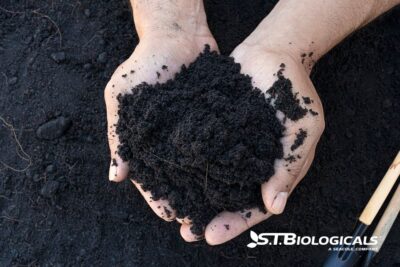Are you, like most farmers, wondering if regenerative ag practices can be profitable in year one? When considering a shift from conventional to regenerative agriculture, you need to know you’re not going to lose the farm while you’re practicing long-term disease prevention.
The answer is Yes! You can be profitable every year, depending on markets and how flexible you are in determining crops.
The secret lies in nurturing healthy soils and robust crops that naturally fend off early plant diseases. Let’s look at how regenerative agriculture techniques, without the need for costly new machinery or synthetic chemicals, can safeguard your row crops, lower input costs, and boost your bottom line.
Are you concerned about the risk of early infections, or are you curious about how sustainable practices can be seamlessly integrated into your operation? These preventative strategies are designed to work with what you already know, with soil and plant health as the driving force.
Regenerative Agriculture: A Better Path to Profitability
Regenerative agriculture focuses on building soil health, increasing biodiversity, and boosting plant resilience. As a conventional farmer, you already understand the value of crop rotation and proper field management. Regenerative ag practices refine these methods to create an ecosystem that naturally resists disease. Early plant diseases can silently reduce yields and increase costs. By concentrating on soil fertility and plant vigor, you set the foundation for robust crops that thrive with fewer chemical inputs.
By shifting your focus to preventative strategies, cultural practices, and physical methods that promote natural balance, you improve the long-term health of your soils and the profitability of your operation. This transformation doesn’t require buying new equipment. Instead, it focuses on tweaking practices that you’re already familiar with.
Natural Cultural Practices for Early Plant Disease Prevention
Preventative measures in regenerative agriculture start with time-tested cultural practices. These methods create a healthier field environment that reduces the chance for pathogens to take hold. You set the stage for resilient crops.
Crop Rotation and Diversity
Crop rotation remains a cornerstone of optimal field management. In regenerative agriculture, crop rotation is taken beyond the basics by incorporating diversity into your planting schedules. Rotating different crops, such as legumes, grains, and pastures, improves soil structure. At the same time, it stimulates a thriving microbial community that naturally suppresses plant diseases. Even a slight modification to your rotation plan can amplify soil health and push back early plant disease in row crops.
Cover crops are one of the most powerful tools for building soil fertility and enhancing plant health naturally. Whether you use cover crops during the off-season or interplant within your row crops, they can significantly reduce erosion, provide organic matter, and improve moisture retention. For example, planting cover crop mixes that include clover or rye shields soil from erosion and reduces the habitat available for harmful pathogens. The result is more vigorous, disease-resistant plants. The more diverse your cover crop mixes, the greater the variety of beneficial microbial populations.
Cleanliness and Field Sanitation: A No-Till Perspective
In regenerative agriculture, fields have a messier look, as planting directly into crop residues or thriving cover crops is best practice in a no-till approach. This method naturally enhances soil structure and fertility while suppressing weeds. Rather than tilling under the remnants of last year’s crops, no-till farming leverages the remaining organic matter to create a healthier, nutrient-rich environment for crops. Cover crops, either physically terminated or left in place, act as a shield against erosion. They also provide habitat for beneficial soil microbes, further supporting plant vigor.
If you’re a conventional farmer transitioning to a no-till system, retrofitting existing equipment can make this shift more manageable. Your tractors and planters can be upgraded with no-till attachments, such as coulters or row cleaners, to effectively plant into residue or cover crops without the need for entirely new machinery. This integration not only minimizes your upfront costs but also allows you to adapt gradually while building soil health and disease resistance.
Optimizing Physical Methods Without New Machinery
Physical methods in regenerative agriculture are about working smarter with what you have rather than investing in heavy new equipment. These techniques optimize environmental conditions, making it harder for early plant diseases to gain a foothold.
Field Drainage, Cover Crops, and Smarter Water Management
Effective water management is at the heart of regenerative agriculture, and practices like no-till and cover cropping naturally complement field drainage strategies. In conventional systems, standing water often requires costly interventions, as it can encourage soil-borne diseases and damage crops.
However, in no-till systems with cover crops, standing water becomes less of a concern except in extreme weather events. Cover crops play a crucial role in improving soil structure and creating natural channels for water infiltration, reducing the likelihood of pooling water. Their root systems act as living drainage networks, moving water deeper into the soil profile while preventing surface runoff.
These benefits extend to overall irrigation efficiency. Fields managed with no-till practices and continuous cover crops retain significantly more moisture, making them less dependent on irrigation. The organic matter contributed by cover crops increases the soil’s water-holding capacity, helping crops stay hydrated even during dry periods. In regions with moderate rainfall, this could mean reducing—or in some cases, eliminating—the need for supplemental irrigation, especially when combined with precise base watering systems like drip irrigation.
By pairing these approaches with mulching, which helps moderate soil temperature and reduce evaporation, farmers can build a system where water is used more efficiently and the risk of waterlogging is minimized. The combined effect of no-till, cover crops, and smarter irrigation systems not only boosts crop health but also makes farms more resilient to the challenges of a changing climate.
The Profitability of Preventative Strategies in Regenerative Agriculture
It might seem ambitious to claim that switching to preventive, regenerative methods can be profitable in the first year—yet the numbers often tell a compelling story.
Immediate Savings by Reducing Chemical Costs
One of the most attractive aspects of transitioning toward regenerative practices is the reduction in chemical inputs. Fewer applications of synthetic pesticides and fungicides mean lower operating costs. With healthier soils and robust plant systems built through cultural and physical practices, early signs of plant disease are minimized. As a result, you not only avoid the cost of reactive chemical treatments but also set up your fields for improved productivity.
Long-Term Benefits and Yield Improvements
Investing in soil health pays off in multiple ways. Healthier soils increase nutrient uptake and water retention, meaning that your plants are naturally more resistant to disease and stress. These benefits translate into higher yields and higher-nutrient profile crops. When your wheat, oats, and soybeans have higher protein profiles, you benefit from higher market prices. Even in the first year, many farmers report noticeable improvements in crop quality and reductions in disease incidence, creating immediate economic benefits.
Smooth Integration with Existing Farm Practices
Perhaps the most compelling point is that regenerative practices are designed to integrate seamlessly into your existing routine. There is no need for expensive new machinery or drastic operational changes. By simply adjusting crop rotations, incorporating cover crops, and almost eliminating the need for irrigation, you align with regenerative agriculture principles that are environmentally and economically sustainable. The shift is gradual, and it builds on the methods you’ve already trusted over the years.
Addressing Concerns: Why Fewer Chemicals Means Healthier Crops
Conventional wisdom might suggest that chemicals are the key to effective disease control. But extensive experience in regenerative agriculture shows otherwise. Excessive chemical use disrupts beneficial soil microbes and undermines plant immunity. Imbalances created over years of chemical use make your crops more vulnerable to disease. In contrast, preventative strategies that harness natural processes help maintain a balanced ecosystem. Healthier soils support robust plant growth and reduce the long-term reliance on chemical inputs. This ultimately creates a more resilient and profitable farming system.
Embracing a Regenerative Future Today
If you’re considering regenerative agriculture, know that the transition is neither radical nor risky. It’s a thoughtful integration of methods that you already know, only refined to build stronger plant health and improved soil vitality. Using regenerative practices reduces early plant disease outbreaks, so you harvest healthier, more productive crops in the short and long terms. Practices such as crop rotation, diverse cover cropping, and no-till reduce the need for irrigation or chemical inputs. Your operation is more profitable from day one.
Regenerative agriculture isn’t a leap into the unknown. It’s a gradual evolution toward a more sustainable future that leverages nature’s own strategies for disease prevention and robust yields.
By taking the first steps toward these natural, preventative methods, you set up a system where profitability meets regeneration. The integration is smooth and builds on your existing expertise. Fewer chemicals and smarter practices deliver a proactive, profitable, and regenerative solution that benefits your bottom line and the health of your land.
Are you ready to see how minor, strategic adjustments in your crop management can lead to big results in quality and quantity of yield, cost savings, and soil vitality? Contact our team at ST Biologicals and let’s work together to transform your conventional practices into a resilient, regenerative system that pays dividends from the get-go. We’re here to help you succeed. When soil speaks, we listen.

